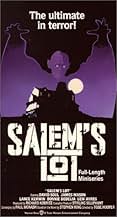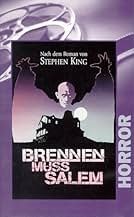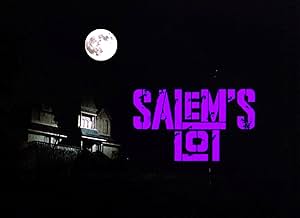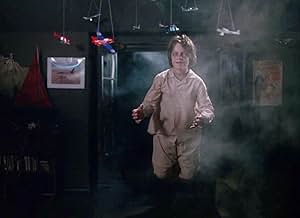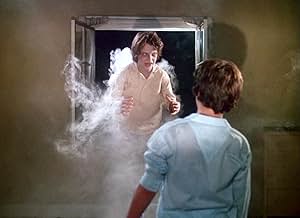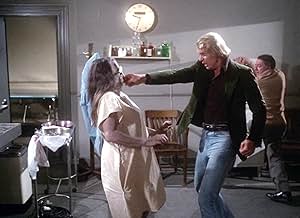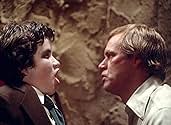Un écrivain et un jeune fan de film d'horreurs tentent de sauver une petite ville de la Nouvelle Angleterre qui a été envahie par les vampires.Un écrivain et un jeune fan de film d'horreurs tentent de sauver une petite ville de la Nouvelle Angleterre qui a été envahie par les vampires.Un écrivain et un jeune fan de film d'horreurs tentent de sauver une petite ville de la Nouvelle Angleterre qui a été envahie par les vampires.
- Nommé pour 3 Primetime Emmys
- 4 nominations au total
Parcourir les épisodes
Avis à la une
This movie is an odd cross between "Peyton Place" and "Nosferatu"...and it works! Set in the small, isolated and somewhat inbred community of Jerusalems Lot (called Salems Lot by the locals) this film is more about small town dirty secrets which are really not secret at all. Everyone knows everyone else's business, gossip is a way of life and the town's mistrust of outsiders is both expected and justified when two men show up in town and a little boy goes missing. This is a story about a small town that just happens to have a vampire in it.
James Mason is elegance personified as the "Renfield" character who sticks out like a sore thumb in this tight-knit community and makes himself the object of suspicion when he moves into the local haunted house and opens up an antique shop. His European accent, expensive suits and somewhat prissy manners make him a hot item of gossip. So too does the arrival of Ben Mears also cause local tongues to start wagging. Mears was born and raised in Salems Lot, having moved away as a small child. He returns as a semi-successful author and a recent widower, haunted by childhood memories of the Marsten House - the local haunted house in which James Mason now resides. Yet another outsider is Mark, a new teen in town with a morbid collection of horror movie paraphernalia. These three characters are drawn together by force as more people go missing and the small town residents, with their narrow vision, cannot accept what is really happening. It is up to the outsiders - the author who knows, the teenager who believes and the human who is a monster - to solve the mystery.
When the vampire finally appears, it is a frightening, exhilarating experience. Reggie Nalder as Barlow, the ancient Master whom James Mason serves, is a disgusting parasite, a physical homage to Nosferatu with his rat-like teeth, his long bony fingers and his hypnotic eyes. He is the frosting on the cake for this excellent film. By the time he makes his appearance, it is almost unnecessary. The paranoia has already decimated the town, and the fear of the unknown is the greatest monster of all. But though he may be unnecessary, he is not unwelcome. He is a wonderful vampire, a truly hideous beast, a fine salute to what a vampire should be - ugly, vile and obscene.
This is one of my all time favorite vampire films, right up there with Nosferatu and Subspecies. To hell with whining, pretentious vampire Pretty Boys - this is the real stuff, and it doesn't get much better than this.
James Mason is elegance personified as the "Renfield" character who sticks out like a sore thumb in this tight-knit community and makes himself the object of suspicion when he moves into the local haunted house and opens up an antique shop. His European accent, expensive suits and somewhat prissy manners make him a hot item of gossip. So too does the arrival of Ben Mears also cause local tongues to start wagging. Mears was born and raised in Salems Lot, having moved away as a small child. He returns as a semi-successful author and a recent widower, haunted by childhood memories of the Marsten House - the local haunted house in which James Mason now resides. Yet another outsider is Mark, a new teen in town with a morbid collection of horror movie paraphernalia. These three characters are drawn together by force as more people go missing and the small town residents, with their narrow vision, cannot accept what is really happening. It is up to the outsiders - the author who knows, the teenager who believes and the human who is a monster - to solve the mystery.
When the vampire finally appears, it is a frightening, exhilarating experience. Reggie Nalder as Barlow, the ancient Master whom James Mason serves, is a disgusting parasite, a physical homage to Nosferatu with his rat-like teeth, his long bony fingers and his hypnotic eyes. He is the frosting on the cake for this excellent film. By the time he makes his appearance, it is almost unnecessary. The paranoia has already decimated the town, and the fear of the unknown is the greatest monster of all. But though he may be unnecessary, he is not unwelcome. He is a wonderful vampire, a truly hideous beast, a fine salute to what a vampire should be - ugly, vile and obscene.
This is one of my all time favorite vampire films, right up there with Nosferatu and Subspecies. To hell with whining, pretentious vampire Pretty Boys - this is the real stuff, and it doesn't get much better than this.
As it really is a wonderful and suspenseful vampire tale! Stephen King - not normally my favorite horror writer - has created one of the absolute BEST modern vampire tales in this story, and this mini-series translation is absolutely true to the feel of his tale! Instead of splatterfest effects , this show hinges itself on a high-tension spiderweb of plotlines and sets up the vampire more as a behind-the-scenes controlling evil. The terror here is not in seeing the monster, it is in NOT seeing him and knowing that he and his minions are out there, somewhere, plotting and planning with the heros stumbling blindly after them like toddlers in the dark. Give this show a chance! It may just scare you!
This is one of the most richly atmospheric films in horror, an article of pure latenight seduction and phosphorescent darkness.
Atmospheric not in the sense that a dry ice machine has pumped a catacomb full of haze and cobwebs are strategically placed in some dark corner, but as a place lived, with naturally dark corners and tangible portents: the old dark house on the hill breathing evil, the antique shop downtown, all velvety smell and musty colors, the small town lined with porticoes bathed in the quiet of a lazy night, yet harboring secrets and vice from inside. Prying eyes staring from behind a curtain.
Oh, at some point vampires come flying through the window, and it's still fine by me, it's one of the better vampire films and at 3 hours it's better fleshed than most of them; but I am just not attuned to the whole vampire lore so I leave this part to be enjoyed best by the traditional horror fan. It is actually one of the more potent retellings of the most familiar story in this field, I was pleasantly surprised to see that it was not quite Dracula but that older film with longer shadows, so I will not spoil the discovery for you.
But the first part intrigues me in stranger ways, more suggestive, with menace that goes unspoken. The small-town facade that would later resurface in Twin Peaks.
There is a notion that matters in all this, but which is not pursued at all; the writer who feels from his perspective that it was his presence that awakened evil, it's fitting that it's coming from a writer because it's a self-centered, imaginative notion, but which from our end we know is bogus. Evil was already afoot, and was never centered around him. But he wistfully imagines himself at the center so he can write about it.
So I don't know what happened with Tobe Hooper. He was never very elegant with a camera, the way Argento was or occasionally Carpenter, but he was unmatched in his feel for the aural qualities of film. He could make a room hum with evil. My guess is that, being an intuitive maker, the feel came and went, or he forgot how to tap into it (you can see as early as Eaten Alive how he seems to be desperately trying to capture again the muse that gave him Texas Massacre). Or he plainly stopped actively chasing after the right material.
This was just right for him. Only Kubrick has better adapted Stephen King to my mind.
Atmospheric not in the sense that a dry ice machine has pumped a catacomb full of haze and cobwebs are strategically placed in some dark corner, but as a place lived, with naturally dark corners and tangible portents: the old dark house on the hill breathing evil, the antique shop downtown, all velvety smell and musty colors, the small town lined with porticoes bathed in the quiet of a lazy night, yet harboring secrets and vice from inside. Prying eyes staring from behind a curtain.
Oh, at some point vampires come flying through the window, and it's still fine by me, it's one of the better vampire films and at 3 hours it's better fleshed than most of them; but I am just not attuned to the whole vampire lore so I leave this part to be enjoyed best by the traditional horror fan. It is actually one of the more potent retellings of the most familiar story in this field, I was pleasantly surprised to see that it was not quite Dracula but that older film with longer shadows, so I will not spoil the discovery for you.
But the first part intrigues me in stranger ways, more suggestive, with menace that goes unspoken. The small-town facade that would later resurface in Twin Peaks.
There is a notion that matters in all this, but which is not pursued at all; the writer who feels from his perspective that it was his presence that awakened evil, it's fitting that it's coming from a writer because it's a self-centered, imaginative notion, but which from our end we know is bogus. Evil was already afoot, and was never centered around him. But he wistfully imagines himself at the center so he can write about it.
So I don't know what happened with Tobe Hooper. He was never very elegant with a camera, the way Argento was or occasionally Carpenter, but he was unmatched in his feel for the aural qualities of film. He could make a room hum with evil. My guess is that, being an intuitive maker, the feel came and went, or he forgot how to tap into it (you can see as early as Eaten Alive how he seems to be desperately trying to capture again the muse that gave him Texas Massacre). Or he plainly stopped actively chasing after the right material.
This was just right for him. Only Kubrick has better adapted Stephen King to my mind.
Without a doubt this television movie based on Stephen King's grand horror opus pales in comparison to its literary counterpart. But isn't that usually the case? Although missing some subplots, many characters, and having some major script changes here and there, Tobe Hooper's Salem's Lot is indeed enjoyable. I watched it right after having read the book, and although I spent a lot of time seeing what it did not have...I have to confess that there were many good points. For starters, let me list some of my major complaints. The whole framed narrative story in the movie is ridiculous and very clumsily made. I also have a big problem with the gaping holes in the script with regard to characters popping up here and there with little or no expository introduction. Some characters were used to help move the plot and then discarded. Names were needlessly changed from the novel. That being said there was a great sense of style to the picture which must be credited to Hooper. Overall the acting is quite good. David Soul is very credible in his leading role, as are Lance Kerwin, Bonnie Bedelia, Lew Ayres and Ed Flanders. James Mason makes a stunning villain. Mason uses charm as a weapon and eats up the scenery with subtlety and wit. The vampire is played by horror veteran Reggie Nalder, and although he says not one word...he is very effective. The make-up on him is very reminiscent of Nosferatu. The lead-ins to commercials show the film to be dated by today's standards, but it has enough in it to be an entertaining diversion. However, PLEASE read the book first as it is one of the best of its kind and will make the film all the more enjoyable if for no other reason than seeing its defects.
The story is pretty interesting and is build up well. The miniseries does an amazing job on building up the atmosphere when the vampires arrived. I really like how the vampirism spreads throughout the townsfolks. The creepiness factor really works well when the vampire shows up because it gives off a eerie vibe to it. And the climax is pretty suspenseful. There's a few flaws with this miniseries. One is that some scenes feels unnecessary and I didn't get the point of it. Also the main vampire doesn't appear a lot and only shows up 2 hours into the miniseries. While he doesn't appear a lot, he's definitely the scariest vampire I ever seen. He looks so freaky and is really threatening villain. The vampire makeup effects are really well made. I really like how the makeup looks so creepy with it's yellow eyes and Barlow blue face. The atmosphere is the best part of the movie. The miniseries does an amazing job building up the suspense to it and the vampire scenes are really effective to be creepy.
Stephen King Movies Ranked by IMDb Rating
Stephen King Movies Ranked by IMDb Rating
See how IMDb users rank the feature films based on the work of Stephen King.
Le saviez-vous
- AnecdotesThe exterior for the Marsten House was actually a full-scale facade built upon a smaller pre-existing hill-top house. In total, the facade cost the production an estimated $100,000 dollars to build. In 1979, an entire house (including the interiors) could have been made for that amount.
- GaffesWhen the younger Glick brother is abducted (and later presumably murdered by Barlow) he's wearing a jacket, t-shirt, dungarees and sneakers. After which, he appears to his brother wearing pajamas.
- Crédits fousThe text of the opening credits appear and dissolve piece by piece into each other in a jigsaw puzzle fashion.
- Versions alternativesSalem's Lot originally aired as a two-night mini-series with the first episode airing on 17 November 1979 and the second episode airing the following week on 24 November 1979.
- ConnexionsFeatured in Stairs (1986)
Meilleurs choix
Connectez-vous pour évaluer et suivre la liste de favoris afin de recevoir des recommandations personnalisées
Détails
Contribuer à cette page
Suggérer une modification ou ajouter du contenu manquant

Lacune principale
By what name was Les vampires de Salem (1979) officially released in India in Hindi?
Répondre

